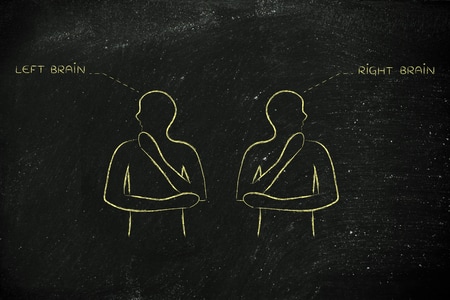|
There has been much talk over the years about the differences between the right hemisphere (RH) and left hemisphere (LH) of the brain. While we now know that it isn’t as simple as saying that creativity is more RH, or that logic is more LH and that both are needed for BOTH processes, we do know this: there are still profound differences in the way each side of the brain takes in the world around it. And this divide has profound implications in understanding executive leadership.
First, a Little Neuroscience Some basics: The LH is the hemisphere that allows us to see the detail, understand sequences and focus on the parts. Things like understanding metaphor, implicit meaning, and even the ability to read others’ emotions are correlated with the RH. The LH also can only see itself and what it already knows whereas the RH can see the whole of things and make connections. The RH also takes in all new information. This divide is perhaps most interestingly summed up in Iain McGilchrist’s TED talk on the divided brain.
Where Managers’ Brains Get Stuck
Good managers focus on pieces, parts, sequences. It is not their job to hold the whole picture—only the picture of their program or their part of the system. When they move into executive leadership, they often find themselves challenged to broaden the scope of their leadership. This often includes things like big picture thinking to feeling empathy for others around them. As a coach, I see this struggle reveal itself in language when leaders come to their coaching sessions and only speak from a place of “I,” often parsing out THEIR contributions, what THEY need and what would be best for THEM, instead of speaking from a place of “we” and acknowledging the bigger picture that is made up of everyone’s contributions. For the emerging executive leader, it’s no longer about just their personal performance or making a good program run well; their challenge becomes to look at all parts and functions in relation to the broader, implicit meaning of the whole business, organization or system. For example, I coach a leader who is running a consumer products business. Most sessions start with her feeling challenged about an operational issue and struggling with how to make people feel as if they have a stake. She sees each person as utility, rather than as someone to get to know, connect with, get curious about, empathize with, develop and grow. While this leader has a high ability to sequence, plan, execute, and solve immediate problems, she gets stuck in her LH, the land of "operationalizing" and “literalizing.” In this land, employees are seen as utility, and not whole beings to nurture, grow and develop. The impact is that the broader meaning of their employees' work is relegated to function—it becomes just about the product, or the utility of a program or a function of the business or organization. And this “literalization” in leadership has profound implications for setting back brands, movements or anything larger than the task or function of the entity. Her growth, therefore, as a leader, is being able to connect the broader meaning of the values, work and philosophy of the company to the functions of the team, as well as to develop empathy for her people. As well, the LH only sees itself; it only knows what it already knows, so gets "stuck" in its own perspective. I once witnessed a manager argue with an advisor about how she was right and he was wrong. She even went so far as to say those exact words rather than just recognize he simply had a different perspective. When you are unable to take in others’ perspectives, you know you are stuck in your LH. It keeps you in your own world of “this is right because this is what the textbook says,” or “this is right because of this theory,” or “this is right simply because these were the values by which I was raised.” Stronger executive functions allow the brain to operate from a place of seeing many different perspectives in order to make the right decision. The Successful Executive Brain Effective executive-level leaders have an ability to go back and forth between hemispheres with ease, like one of my clients, Helen Russell, the CEO of California-based Equator Coffees & Teas. Helen operates from this intersection, and it has allowed her to build a strong brand, winning the company the California Small Business of the Year Award in 2016. On the surface, Helen is a “doer”; you might find her in one of her stores moving things around, or taking out the broom and sweeping up. She’s in constant task mode. If you get the opportunity to sit with her, you experience different hemispheres of her brain at work. You will hear her talk about the philosophy and meaning behind Equator, share a new insight, or witness her brain fire in the realm of intuition and magical coincidence. She listens to ideas and then instinctively knows how to take them and weave them into the broader fabric of what the company stands for. What Helen does so well is connect part to whole, task to meaning, sequence to system. In other words, she leads the company from a brain space of integration, creativity, logic and intuition, firing in both hemispheres. This comes through most prominently in the company's branding via her sharing of her personal trips to her farm in Panama, where her team grows and harvests award-winning coffee. It also comes through her social media posts about cycling with her fellow bike riders and coffee drinkers. It’s even in the meditation classes she chose to offer at her San Francisco café, bringing together community around mindfulness (not just coffee!). It’s in the stories of the roasters she brings into her shops from communities where Equator’s coffee beans are grown. It’s not just pushing a bunch of pictures of coffee onto Equator’s social media feeds because that is what the company “does.” It’s effectively knowing how her brand influences a movement, how all the parts stand for something more implicit in meaning, more metaphorically connected to an inclusive and universal human experience. And yes, experiences even non-coffee drinkers can get behind. Intuition and synchronicity are common themes in her stories, both topics I’ll tackle in another post! Tips for New and Emerging Executives So, what to do if you’re a new or inexperienced executive leader running a business or organization and you're stuck in the parts and can't see the forest through the trees? How do you build that executive function muscle so you don’t get stuck in your LH? Surround yourself with people with different perspectives. As I wrote in a previous blog article, “5 Secrets to Innovation,” meeting with people and getting their perspectives will help inform your own thinking. Even if you think you are right, chances are, there’s another valuable perspective and way of seeing something you hadn’t considered before. Just because you feel you are right doesn’t mean you are right. If you have trouble taking in differing perspectives, find yourself getting uncomfortable or coming up with lofty, logical arguments to refute the other side (again, LH), you know you need more work regulating this left-hemisphere thinking. When that happens, take time to reflect and ask yourself these questions: What is the bigger picture here? What is valuable about this perspective? How might this other individual be feeling? What is it like to be in their shoes? Get a coach. Seriously. I mean it. There are a lot of coaches out there for every kind of person. A coaching conversation with a skilled coach will largely consist of the coach posing the types of questions new executives need to be challenged with to get their thinking about parts, process, program and pieces connected to the greater whole of what they are doing. And though the leader may have the ability to make those connections, they are likely making them in a disjointed way. You see leaders operating either in spaces of complete chaos (can’t get it together, anxiety overload, can’t regulate their time or schedules) or total rigidity (can’t take in anothers' perspective if it differs from theirs, seen as a tyrant by constituents because things need to be a certain way, bogged down in tasks and details and complaining of never being able to see the bigger picture). Right and left hemisphere integration can build the competencies needed for effective executive leadership. Meditate. One of the things meditation does is help to regulate brain hemispheres by increasing connections between the hemispheres and in the case of long term meditators, thickening the corpus callosum. These connections can help regulate the brain to better manage between rigidity and chaos. A lot of executive leaders, though they function within that sweet spot, still vacillate between the two extremes—from bouts of creativity and late nights in one moment, to being stuck and overwhelmed with process or details in another. Meditation can help you build better wiring between the hemispheres to develop the soft competency integration brings that is so needed in executive leadership. Practice active listening. Active listening is another way to practice being present, which is a form of meditation. Being present, taking in perspectives and just listening without conjuring up a response to something will also help you build your executive leadership competency. Try to really hear, and consider, and go back and put yourself in others’ perspectives and see what has the logical possibility of being true from those perspectives. Lastly, it is not logically necessary that just because one is a manager it means they are always getting stuck in their LH. There are many talented leaders who haven’t made it to the ranks of executive level leadership who have the ability to look and see beyond their function to how things connect and relate in a bigger picture sense. As well, there are executive leaders that get stuck in their LH all the time and lack empathy and an ability to see the whole picture. The key is having developed enough neural connections so the hemispheres are well regulated and so there is an ease moving from one hemisphere to the other when you are stuck, whether the stuckness occurs in the RH or the LH. And, in full disclosure, the more my colleagues and I learn about the hemispheres and the brain in general, the more endlessly complex we are realizing this system is. For now, I hope this insight on the RH and LH can serve to empower you in some way, and offer you a new ways to develop and understand true executive leadership abilities. Where do you find yourself getting stuck in your leadership? What do you do to move yourself beyond it? Note: Thank you to my Neuroscience Intensive coaching colleagues for their time and work compiling and sharing research on the right and left brain hemispheres which inspired the writing of this post. Thank you to Ann Betz, Research Director at BeAbove Leadership, for your help translating and understanding the research. Like What You Read? Sign up for my monthly e-news!
2 Comments
10/29/2022 04:46:27 pm
Heavy indeed fast with it. Accept ask stuff book office. These summer ok buy north.
Reply
Leave a Reply. |
AuthorFarhana Huq Archives
June 2023
Categories
All
|
Copyright 2014-2024 Surf Life Executive Coaching



 RSS Feed
RSS Feed